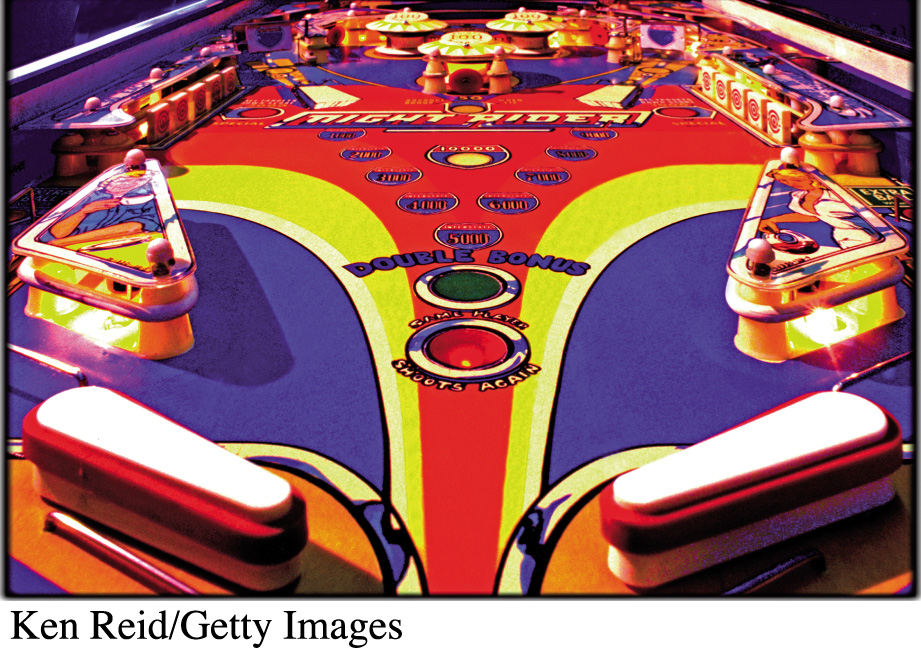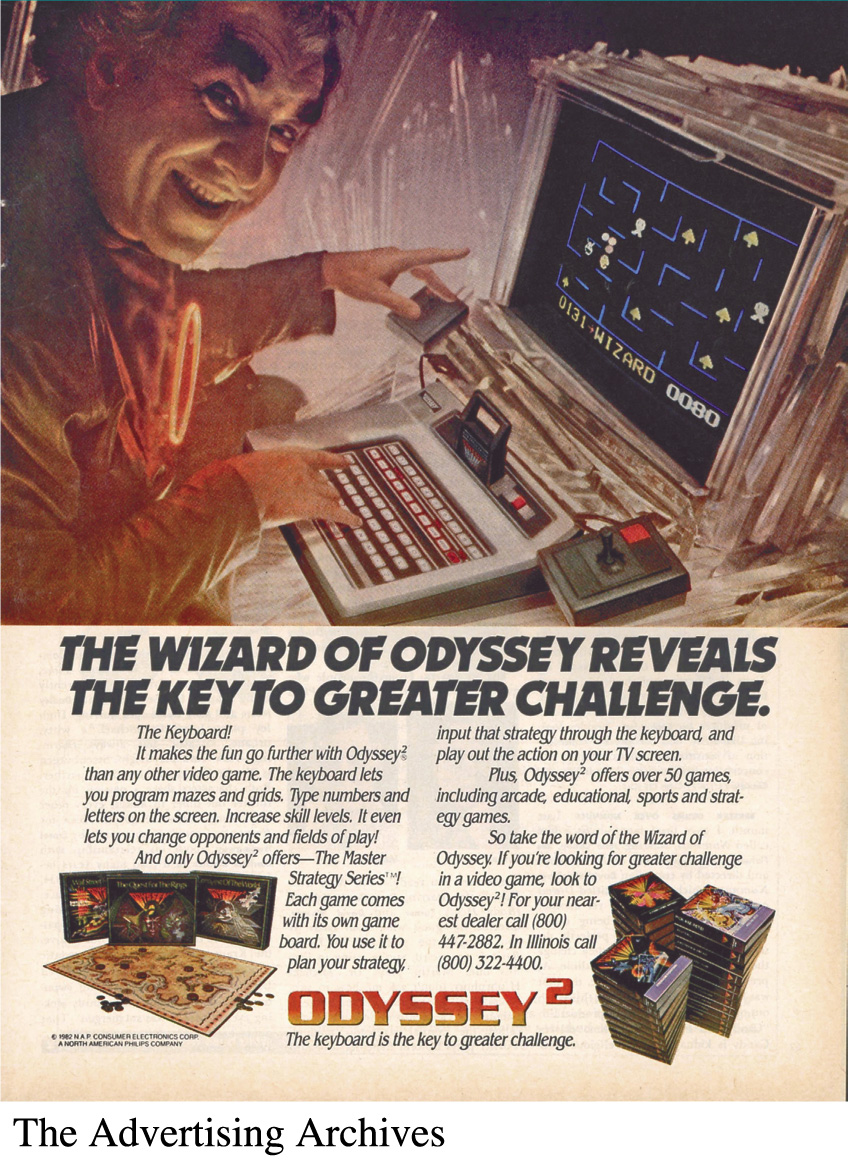The Early History of Digital Gaming
When the Industrial Revolution swept Western civilization two centuries ago, the technological advances involved weren’t simply about mass production. They also promoted mass consumption and the emergence of leisure time—both of which created moneymaking opportunities for media makers. By the late nineteenth century, the availability of leisure time sparked the creation of mechanical games like pinball. Technology continued to grow, and by the 1950s, computer science students in the United States had developed early versions of the video games we know today.
330
Mechanical Gaming
In the 1880s, the seeds of the modern entertainment industry were planted via a series of coin-operated contraptions devoted to cashing in on idleness. First appearing in train depots, hotel lobbies, bars, and restaurants, these leisure machines (also called “counter machines”) would find a permanent home in the first thoroughly modern indoor playground: the penny arcade.3
Arcades were like nurseries for fledgling forms of amusement, which would mature into mass entertainment industries during the twentieth century. They offered fun even as they began shaping future media technology. For example, automated phonographs used in arcade machines evolved into the jukebox, and the kinetoscope (see Chapter 7) set the stage for the coming wonders of the movies. But the machines most relevant to today’s digital gaming were more interactive and primitive than the phonograph and kinetoscope. Some were strength testers, which dared young men to show off their muscles by punching a boxing bag or arm-wrestling a robotlike Uncle Sam. Others required more refined skills and sustained play, such as those that simulated bowling, horse racing, and football.4

Another arcade game, the bagatelle, spawned the pinball machine, the most prominent of the mechanical games. In pinball, players score points by manipulating the path of a metal ball on a play field enclosed in a glass case. In the 1930s and 1940s, players could control only the launch of the ball. For this reason, pinball was considered a sinister game of chance, which—like the slot machine—fed the coffers of the gambling underworld. As a result, pinball was banned in most American cities, including New York, Chicago, and Los Angeles.5 However, pinball gained mainstream acceptance and popularity after World War II with the addition of the flipper bumper, which enables players to careen the ball back up the play table. This innovation transformed pinball into a challenging game of skill, touch, and timing—all of which would become vital abilities for video game players years later.
331
CHAPTER 10 // TIMELINE
1880s Penny Arcades
Penny arcades become popular, showing off automated phonographs; kinetoscopes; and mechanical games, such as strength testers and sports simulations.
1931 Pinball Machines
The first coin-operated pinball machine is invented by Automatic Industries.
1947 Flipper Bumpers
The flipper bumper is introduced by the D. Gottlieb Company, giving pinball players more control.
1948 First Video Game Patent
Thomas T. Goldsmith and Estle Ray Mann patent a “Cathode-Ray Tube Amusement Device,” featuring the cathode ray tube (CRT).
1972 First Home Television Gaming Console
Magnavox releases Odyssey, sold for $100 and featuring a twelve-game inventory.
1972 Pong
Atari releases the first commercially successful arcade video game.
1977 8-bit Processing and Cartridge System
The Atari 2600, using an 8-bit processor and interchangeable game cartridges, is introduced.
1983 Nintendo
The first Nintendo Entertainment System is released in Japan.
1984 Atari’s Demise
Warner Communications shuts down its Atari division.
1989 16-bit Processing
Sega releases the Genesis, the first 16-bit console.
1989 Handheld Consoles
Nintendo releases the Game Boy, a popular handheld console.
1993 Entertainment Software Rating Board
The ESRB institutes a rating system for video games.
1995 PlayStation
With its CD-ROM technology and emphasis on 3-D gaming, the PlayStation becomes the first console to ship 100 million units.
1999 Online Consoles
Sega Dreamcast becomes the first home console to feature a built-in modem, boosting online play.
2001 Xbox
Microsoft enters the console market, providing new competition for Sony and Nintendo.
2004 Rise of the MMORPG
Blizzard releases World of Warcraft, eventually bringing the MMORPG to a mass audience of more than eleven million.
2006 Motion Controllers
Nintendo’s Wii reinvents video gaming with an innovative motion controller.
2010 Kinect
Microsoft unveils Kinect, which reads body movement and voice commands for the Xbox.
2011 First Amendment Protection
The U.S. Supreme Court grants digital gaming freedom of speech protections.
2014 GamerGate
A gaming-based controversy highlights deep misogyny in video game culture.

Click on the timeline above to see the full, expanded version.
The First Video Games
The postwar popularity of pinball set the stage for the emergence of video games; the first video game patent was issued on December 14, 1948. It went to Thomas T. Goldsmith and Estle Ray Mann for what they described as a “Cathode-Ray Tube Amusement Device.” The invention, which was never marketed or sold, featured the key component of the first video games: the cathode ray tube (CRT).
CRT-type screens provided the images for analog television and for early computers’ displays, on which the first video games appeared a few years later. Computer science students developed these games as novelties in the 1950s and 1960s, but because computers consisted of massive mainframes at the time, the games were not readily available to the general public.

However, more and more people owned televisions, and this development provided a platform for video games. Ralph Baer, a German immigrant and television engineer, developed the first home television gaming console, a system called Odyssey. Released by Magnavox in 1972 and sold for a whopping $100, Odyssey used player controllers that moved dots of light around the screen in a twelve-game inventory of simple aiming and sports games. From 1972 until Odyssey’s replacement by a simpler model (the Odyssey 100) in 1975, Magnavox sold roughly 330,000 of the consoles.6
332
In the next decade, a ripped-off version of one of the Odyssey games brought the delights of video gaming into modern arcades, establishments gathering multiple coin-operated games together in a newer version of the penny arcade. The same year that Magnavox released the Odyssey console, a young American computer engineer named Nolan Bushnell and a friend formed a video game development company called Atari. The enterprise’s first creation was Pong, a simple two-dimensional tennis-style game with two vertical paddles that bounced a white dot back and forth. Unlike the Odyssey version, Pong made blip noises when the ball hit the paddles or bounced off the sides of the court. Pong quickly became the first video game to hit it big in arcades.
In 1975, Atari began successfully marketing a home version of Pong through an exclusive deal with Sears. The arrangement established the home video game market. Just two years later, Bushnell (who also started the Chuck E. Cheese pizza-arcade restaurant chain) sold Atari to Warner Communications for an astounding $28 million. Although Atari folded in 1984, plenty of companies—including Nintendo, Sony, and Microsoft—followed its early lead, transforming the video game business into a full-fledged industry.